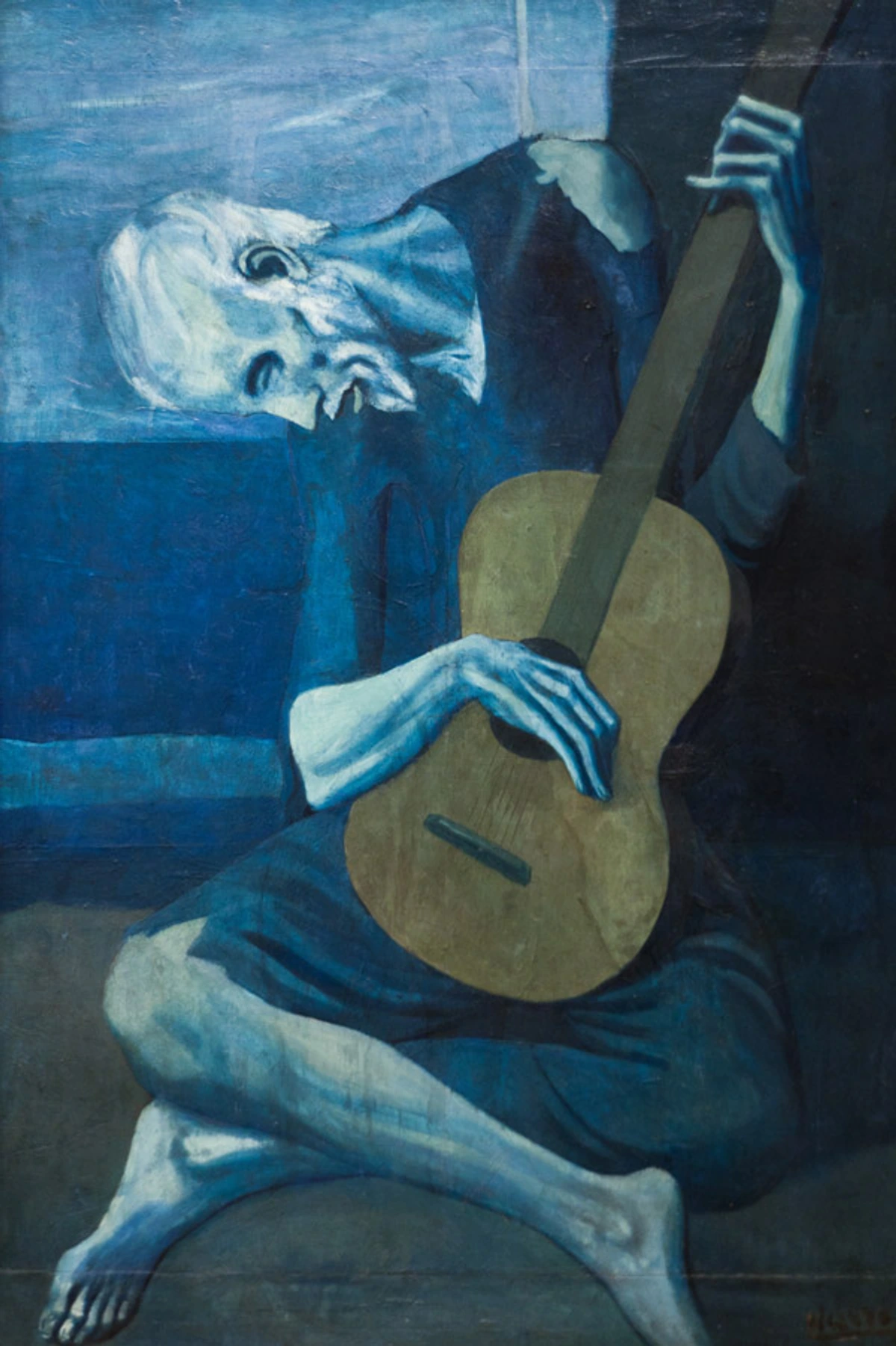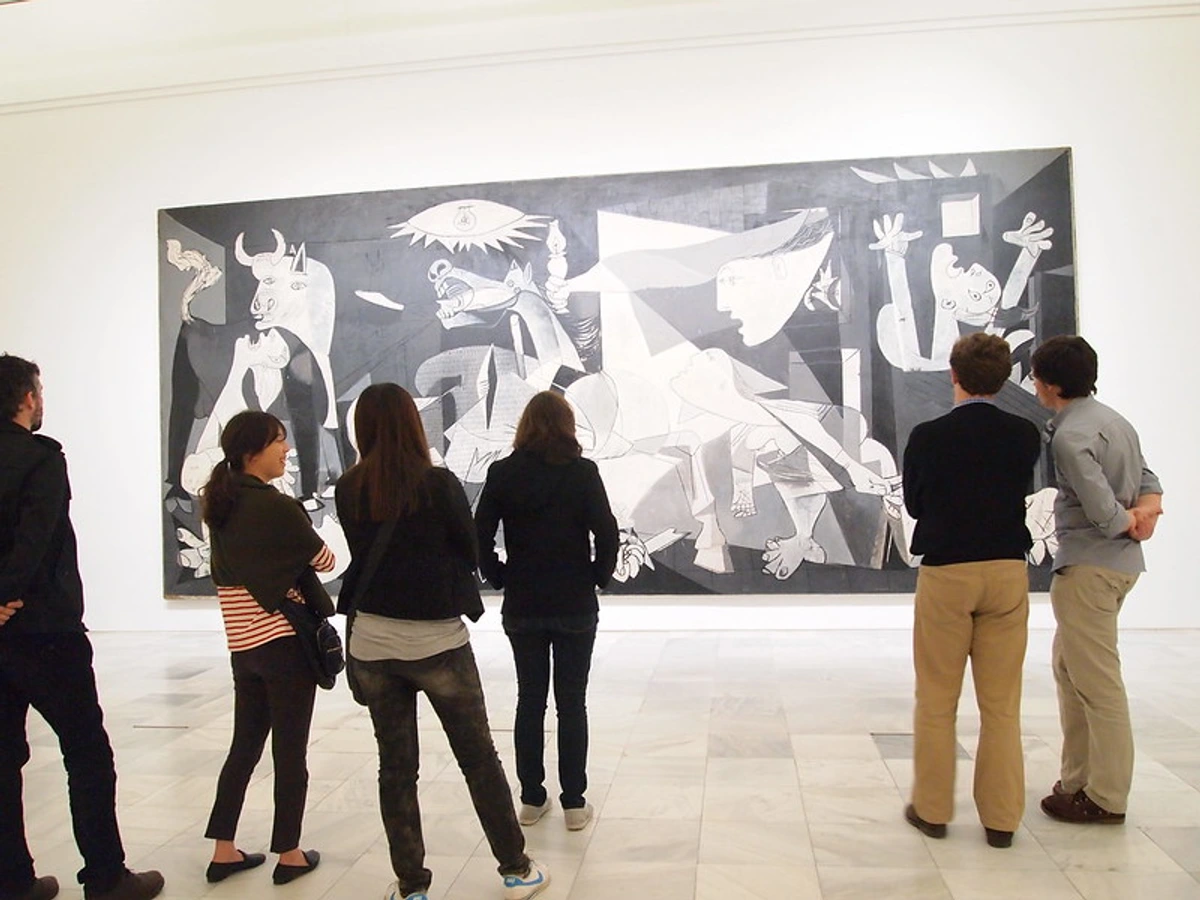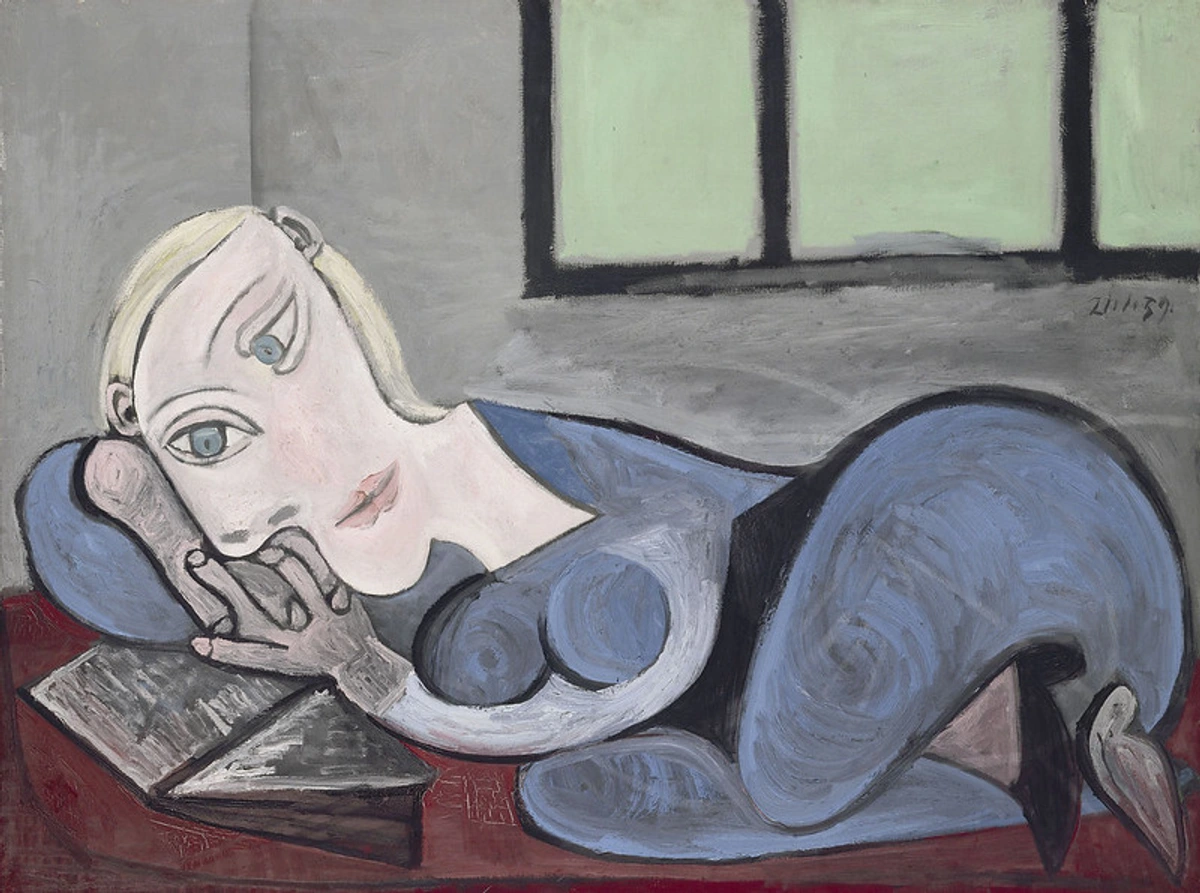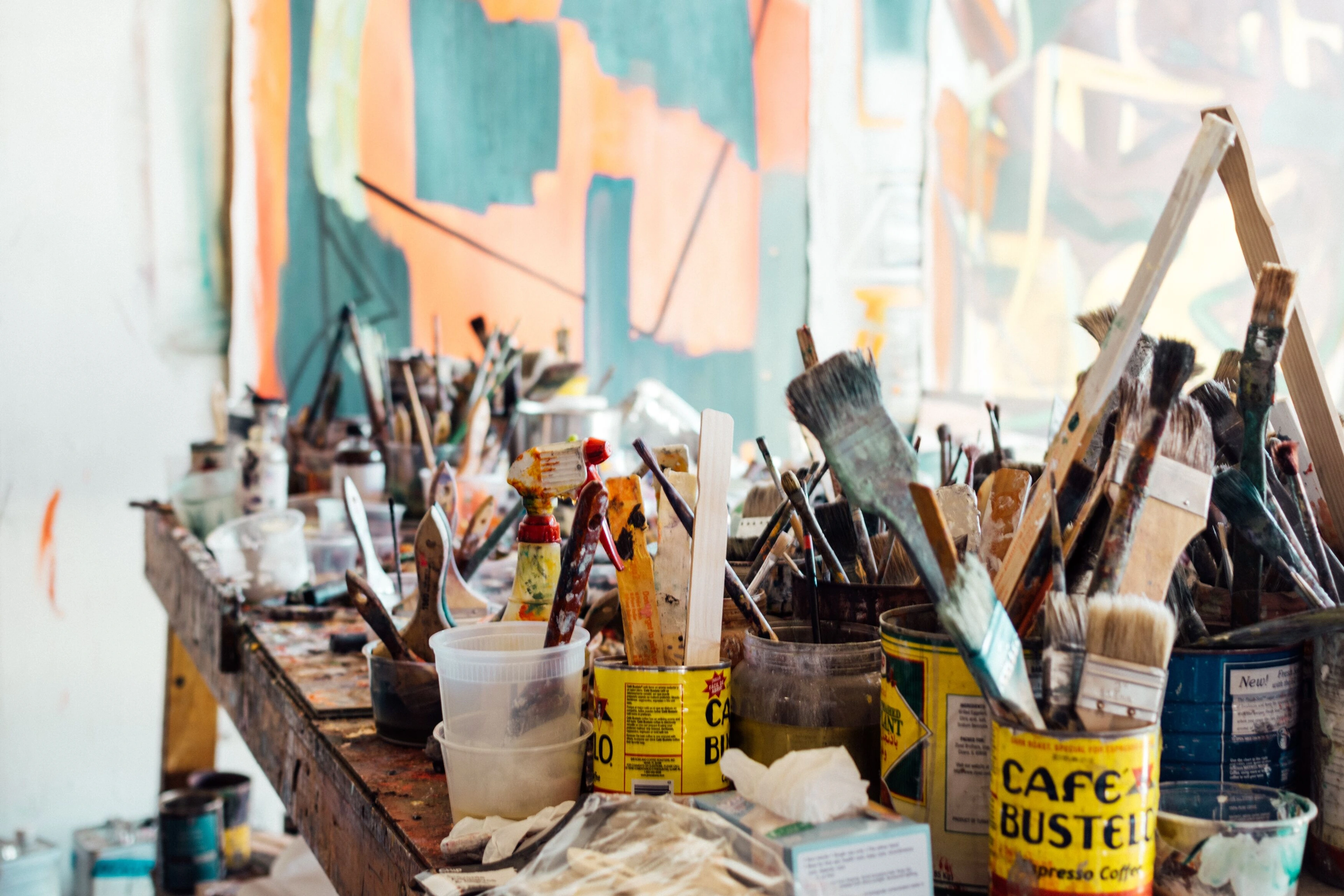
Ultimate Guide to Picasso: His Life, Art Periods & Work
Explore the ultimate guide to Pablo Picasso. Discover his life, revolutionary art periods (Blue, Rose, Cubism), key works like Guernica, and lasting legacy.
The Ultimate Guide to Pablo Picasso: Life, Periods, Work & Legacy
Pablo Picasso (1881-1973). The name itself resonates like a thunderclap in the history of art. A Spanish painter, sculptor, printmaker, ceramicist, and stage designer, he wasn't just an artist; he was arguably the dominant figure of 20th-century art, a colossus whose influence remains inescapable. His relentless innovation, stylistic transformations, and staggering output redefined what art could be, making him one of the top artists ever.
Approaching Picasso can feel a bit like staring up at a mountain range – you know it's huge, magnificent, maybe a little intimidating, and you're not quite sure where to start the climb. But understanding Picasso is key to understanding the trajectory of Modern Art itself. His life spanned immense social and political upheaval, and his art constantly reflected and refracted the changing world around him. This comprehensive guide aims to navigate the vast universe of Picasso: his life's journey, his revolutionary artistic periods, his mastery across diverse media, and his enduring impact on art and culture.
Picasso's Life: A Brief Timeline of a Prolific Journey
Picasso's life was as dynamic and multifaceted as his art:
- Early Years (1881-1901): Born Pablo Ruiz Picasso in Málaga, Spain, he was a child prodigy, allegedly learning to draw before he could talk. Encouraged by his artist father, he received formal art education in Barcelona and Madrid, quickly mastering academic techniques. Barcelona, especially, with its burgeoning Modernisme movement and lively café culture at places like Els Quatre Gats, provided fertile ground for his early experiments beyond strict academicism. You can almost imagine the young, ambitious artist soaking it all in, already hungry for something new.
- Parisian Immersion (1901 onwards): Drawn to the epicenter of the art world, Picasso moved permanently to Paris in 1904. He immersed himself in the avant-garde circles of Montmartre and Montparnasse – think smoky studios, passionate debates lasting till dawn, a melting pot of artistic rebellion. He befriended influential writers like Guillaume Apollinaire and Gertrude Stein, who became early patrons and champions. It wasn't just about painting; it was about living the art, breathing the revolution.
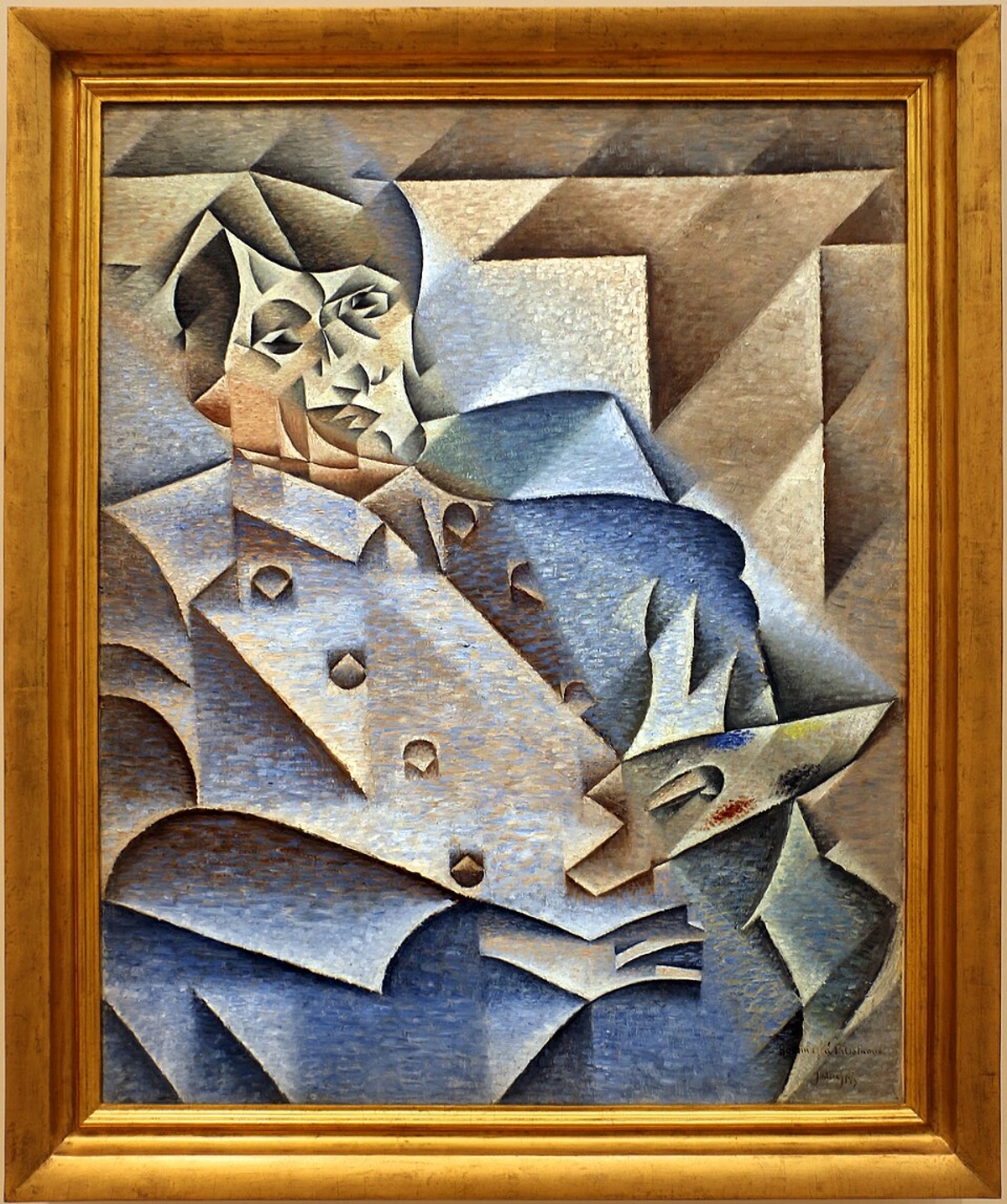 credit, licence
credit, licence - Muses and Relationships: Picasso's art is inextricably linked to the women in his life. His relationships with figures like Fernande Olivier, Olga Khokhlova (his first wife), Marie-Thérèse Walter, Dora Maar, Françoise Gilot, and Jacqueline Roque (his second wife) profoundly influenced his style and subject matter during different periods. These weren't just passive models; they were collaborators, lovers, rivals, and integral parts of his creative universe, though his treatment of them remains a complex and often criticized aspect of his biography.
- War and Politics: The horrors of the Spanish Civil War prompted his monumental anti-war statement, Guernica (1937). He remained in Paris during the Nazi occupation in WWII, becoming a symbol of artistic resistance – a quiet defiance through continued creation. He later joined the Communist Party and created works promoting peace, like his famous Dove of Peace.
- Later Life in the South of France (Post-WWII - 1973): Seeking sun and tranquility (or perhaps just a new stage), Picasso moved to the South of France. In Vallauris, he enthusiastically took up ceramics, producing thousands of pieces with almost childlike glee. He continued to paint, sculpt, and print prolifically until his death in Mougins in 1973 at the age of 91, leaving behind an unparalleled artistic legacy. His incredibly long and varied creative output mirrors the idea of the persistent artistic journey many artists undertake, constantly seeking, changing, and producing.
The Ever-Changing Styles: Picasso's Major Artistic Periods
Picasso famously said, "To copy others is necessary, but to copy oneself is pathetic." He constantly reinvented his style, moving through distinct periods. While dates are approximate and styles sometimes overlapped, these are the key phases:
Period | Approx. Dates | Key Characteristics | Iconic Work Example |
|---|---|---|---|
| Early Work | Pre-1901 | Academic realism, technical mastery | Science and Charity |
| Blue Period | 1901-1904 | Predominantly blue palette, melancholic themes (poverty, despair) | The Old Guitarist |
| Rose Period | 1904-1906 | Warmer colors (pinks, oranges), circus performers, harlequins, more optimistic | Family of Saltimbanques |
| African / Proto-Cubism | 1907-1909 | Influence of African/Iberian art, angular forms, fractured planes | Les Demoiselles d'Avignon |
| Analytic Cubism | c. 1909-1912 | Deconstruction of objects, multiple viewpoints, monochromatic (browns, grays) | Portrait of Ambroise Vollard |
| Synthetic Cubism | c. 1912-1919 | Collage (papier collé), brighter colors, simpler forms, constructing images | Still Life with Chair Caning |
| Neoclassicism | c. 1918-1925 | Return to classical, monumental figures, often coexisted with Cubism | Three Women at the Spring |
| Surrealism Influence | c. 1925+ | Distorted figures, biomorphic shapes, psychological intensity | Seated Bather |
| Wartime Work / Guernica | 1937-1945 | Dark themes, anguish, political statements (Guernica), works from occupied Paris | Guernica, Weeping Woman |
| Later Years | Post-WWII-1973 | Variations on Masters, ceramics, prolific printmaking, energetic late style | Las Meninas Variations |
Overlap and Transition: Not Always Neat Boxes
It’s tempting to think of these periods as distinct chapters in a book, each ending neatly before the next begins. But reality, especially Picasso’s reality, was much messier and more interesting. Styles often bled into one another, ideas from one period would resurface years later, and sometimes he even worked in multiple styles concurrently. For instance, his Neoclassical phase didn't entirely replace Cubism; they ran in parallel, demonstrating his ability to explore different visual languages simultaneously. It’s less like switching channels and more like having multiple TVs on at once – a testament to his restless creative energy.
Deeper Dive into Key Periods:
- Blue Period (1901-1904): Triggered partly by the suicide of his close friend Carlos Casagemas, this period saw Picasso depict the outcasts and downtrodden of society in predominantly blue tones, conveying deep melancholy and empathy. Looking at works like The Old Guitarist, you feel the chill, the weight of despair – it's a stark, emotional punch rendered in cool hues.
- Rose Period (1904-1906): A shift towards warmer colors coincided with his move to the Bateau-Lavoir studios and his relationship with Fernande Olivier. Subjects often involved circus performers, reflecting a bohemian lifestyle but still tinged with introspection. The mood lifts, but there’s still a certain quietude, a sense of figures lost in thought even amidst the supposed gaiety of the circus.
- African Period / Proto-Cubism (1907-1909): Inspired by the formal power of African masks and ancient Iberian sculptures he saw in Paris museums (perhaps the Trocadéro), Picasso began radically simplifying and distorting forms, breaking from Western naturalism. It wasn't about copying these forms directly, but about absorbing their raw expressive power and formal abstraction. Les Demoiselles d'Avignon (1907) is the explosive, pivotal work of this phase, prefiguring Cubism. Imagine the shockwaves this sent through the Paris art world – it was a declaration of war on traditional beauty.
- Cubism (c. 1909-1919): Developed alongside Georges Braque, Cubism was perhaps Picasso's most revolutionary contribution.
- Analytic Cubism: Objects were fragmented into geometric shapes, analyzed from multiple angles simultaneously, and rendered in muted colors to focus on form. It's like looking at an object through a shattered prism, trying to piece reality back together.
- Synthetic Cubism: Moved towards constructing images from simplified shapes, incorporating real-world materials like newspaper clippings, wallpaper, and chair caning (collage), and using brighter colors. This playful introduction of 'real' stuff into the 'art' space was mind-bending at the time.
- Neoclassicism (c. 1918-1925): Following WWI and a trip to Italy, Picasso explored more traditional, solid, sculptural forms inspired by classical antiquity. This "return to order" coexisted with his ongoing Cubist explorations. Some saw it as a retreat, others as another facet of his relentless exploration of form, proving he could master – and manipulate – any style.
- Guernica (1937): Created in response to the bombing of Guernica during the Spanish Civil War, this monumental monochrome canvas is one of the most powerful anti-war statements ever painted, depicting the suffering and chaos inflicted upon civilians. Its scale and raw emotion are overwhelming in person.
Beyond Painting: Picasso the Multi-Media Innovator
Picasso's creative energy couldn't be contained by canvas alone. He attacked every medium with the same ferocious curiosity. It wasn't just about being a 'painter who also sculpted'; he fundamentally changed the game in these other areas too.
- Sculpture: He pioneered constructed sculpture (assembling found materials, like his Guitar) and assemblage (Bull's Head made from bicycle parts). He worked in bronze, wood, wire, plaster, and sheet metal, constantly pushing boundaries. He wasn't just depicting things; he was building them, making sculpture less about carving away and more about putting together.
- Printmaking: A master printmaker throughout his life, he created thousands of prints using etching, drypoint, aquatint, lithography, and, particularly in his later years, innovative linocuts. For Picasso, printmaking wasn't a secondary activity; it was a core part of his practice, allowing for experimentation, multiplication, and variation on themes.
- Ceramics: In the late 1940s, Picasso settled in Vallauris and embraced ceramics with immense enthusiasm, decorating plates, jugs, and vases and creating sculptural forms, revitalizing the local pottery industry. There’s a sense of playfulness and freedom in his ceramics; you feel him enjoying the directness of the medium, transforming everyday objects into art with a flick of his brush or a twist of clay. It’s almost like he rediscovered a childlike joy in making things with his hands.
- Stage Design: He collaborated with Sergei Diaghilev's Ballets Russes, designing avant-garde costumes and sets for productions like Parade (1917), Pulcinella (1920), and Mercure (1924). These weren't just backdrops; they were immersive Cubist environments, bringing his radical vision to the stage.
Recurring Themes and Obsessions
Certain themes reappeared throughout Picasso's long career, viewed through the changing lenses of his styles and life experiences:
- Love, Desire, and the Muse: His portraits and depictions of women are a vast and complex body of work, reflecting the intense relationships with his partners.
- War, Suffering, and Peace: Most powerfully expressed in Guernica, but a recurring concern.
- Mythology: He frequently drew on classical myths, particularly the figure of the Minotaur, often seen as a complex self-representation – part man, part beast, trapped in a labyrinth of his own making perhaps?
- The Artist and His Model: A relentless exploration of the creative act itself and the dynamics between artist and subject. It’s a theme that goes beyond just painting someone; it’s about the power of the gaze, the transformation of reality into art, the intense, sometimes fraught, relationship between creator and created. You see him wrestling with this constantly, sometimes tenderly, sometimes almost violently.
- Bullfighting: A spectacle of life, death, ritual, and Spanish identity that fascinated him from childhood. The drama, the color, the violence, the elegance – it all fed into his art.
Analyzing Key Masterpieces Across Periods
While Les Demoiselles d'Avignon and Guernica are landmark works, exploring other key pieces reveals the nuances of his evolution:
- The Old Guitarist (1903-1904, Blue Period): Epitomizes the Blue Period's pathos. The elongated, emaciated figure hunched over his guitar, rendered almost entirely in shades of blue, powerfully conveys themes of poverty, isolation, and artistic suffering. It shows his early mastery of expressive form even within a limited palette. Understanding the symbolism of color here is key.
- Still Life with Chair Caning (1912, Synthetic Cubism): A revolutionary work marking a shift in Cubism. Picasso incorporates a piece of oilcloth printed with a chair-caning pattern (a found object) and frames the oval canvas with actual rope. This introduction of real-world materials into the artwork blurred the lines between painting and sculpture, reality and representation, defining Synthetic Cubism's constructive approach. It’s a visual pun, a game with reality – is it a painting of chair caning, or is it chair caning?
- Guitar (1912-1914, Sculpture): One of his groundbreaking constructed sculptures. Rather than carving or modeling, Picasso assembled planes of sheet metal and wire to build the form of a guitar in space. It radically challenged traditional notions of sculpture as solid mass, focusing instead on volume defined by planes and voids. It’s like he drew the guitar in three dimensions.
- Bull's Head (1942, Assemblage): A brilliantly simple yet profound example of assemblage. Picasso took the saddle and handlebars of a bicycle and combined them to evoke the form of a bull's head. This act of transformation, finding unexpected meaning in everyday objects, is characteristic of his wit and inventive spirit. Sometimes I look at random objects and wonder what Picasso might have turned them into – it’s that kind of lightning-strike genius, seeing potential where others see junk.
- Las Meninas Variations (1957, Later Years): Picasso created an extensive series of paintings reinterpreting Diego Velázquez's masterpiece Las Meninas. This obsessive dialogue with a past master demonstrates his deep engagement with art history and his relentless drive to analyze, deconstruct, and reinvent even iconic works through his own distinct visual language. Such deep dives into past masters often provide rich art inspirations for artists on their own journey. It's like he was having a conversation across centuries, arguing with Velázquez, celebrating him, and ultimately making the painting his own.
Picasso's Enduring Legacy and Influence
Picasso's impact on 20th and 21st-century art is immeasurable:
- Revolutionizing Form: Cubism fundamentally changed Western art by dismantling traditional perspective and representation, opening doors for abstraction and countless other movements.
- The Modern Artist Archetype: He embodied the notion of the artist as a relentless innovator, a cultural celebrity whose life and work were intensely scrutinized, and a powerful creative force. He made being an artist seem both incredibly serious and fantastically glamorous.
- Inspiration for Generations: His willingness to experiment, mastery of diverse media, and sheer creative energy continue to provide rich art inspirations for artists today. Whether consciously or not, artists are often working either with or against the shadow he cast.
- Market Dominance: Picasso remains a titan of the art market. His works consistently achieve record prices at auction, influencing perceptions of artwork value.
- Dialogue with Contemporaries: Picasso's career was marked by intense dialogue, rivalry, and mutual influence with other giants of modern art, most notably Henri Matisse and Georges Braque. His collaboration with Braque was fundamental to the development of Cubism – they were like two mountaineers roped together on an unknown peak. His relationship with Matisse was one of lifelong respect and artistic competition, a fascinating push-and-pull that arguably spurred both to greater heights.
- Paving the Way for Future Art: Cubism's fragmentation and multi-perspectival view directly influenced Futurism, Constructivism, and Orphism. His playful use of found objects in sculpture impacted Dada and Surrealism, and later assemblage artists. His expressive distortions influenced Abstract Expressionism and beyond. Even artists working today often grapple with Picasso's shadow, either reacting against it or building upon his innovations. Exploring the work of contemporary artists can sometimes reveal echoes or deliberate departures from Picassian ideas.
- Broad Cultural Icon: Picasso transcended the art world to become a global cultural icon. His image, distinctive style, and life story have permeated popular culture, solidifying his status as the archetypal modern artist genius.
- Critiques and Complexities: While his artistic genius is undeniable, contemporary perspectives often grapple with the more difficult aspects of his life and legacy. His treatment of the women in his life has drawn significant criticism, prompting re-evaluations of the relationship between his biography and his art. Some critics also argue that the quality and innovation of his extremely late work declined, though others celebrate its raw energy and freedom. Acknowledging these complexities is part of understanding the artist today.
Picasso's Working Methods and Studio Practice
How did one man produce so much work? Part of the legend is the image of Picasso working with feverish intensity, often late into the night, driven by an inexhaustible creative urge. Eyewitness accounts and photographs depict studios overflowing with canvases, sculptures, found objects – a creative chaos from which masterpieces emerged.
Unlike some masters who relied heavily on large workshops, Picasso, while occasionally having assistants for specific tasks (like printing or ceramics), was known for his very hands-on approach. The mark-making, the compositional decisions, the essential creative act – that was typically all him. He revisited themes and motifs repeatedly, creating vast series (like the Las Meninas Variations or countless portraits of his muses) where he would exhaustively explore an idea from every conceivable angle. It wasn't just about sudden inspiration; it was also about relentless work and obsessive exploration. Maybe that’s the real secret – not just talent, but an almost superhuman capacity for sustained creative labor. It makes my own occasional bursts of productivity feel rather quaint!
Picasso and the Written Word
While primarily a visual artist, Picasso also had a relationship with writing, particularly poetry. Starting in the mid-1930s, during a period of personal turmoil and perhaps artistic searching, he turned to automatic writing, influenced by his Surrealist friends like André Breton and Paul Éluard. His poems are often dense, imagistic, and stream-of-consciousness, much like some of his more complex visual work. He also penned a couple of Surrealist plays. This foray into writing wasn't just a sideline; it seemed to feed back into his visual art, adding another layer to his exploration of expression and the subconscious. His deep friendships with poets and writers like Apollinaire, Cocteau, and Stein also underscore the vital cross-pollination between literature and visual art in the modernist era.
Where to See Picasso's Art: Key Museums
Experiencing Picasso's work in person is essential. Major collections are housed in:
- Musée National Picasso-Paris: The world's largest collection, spanning all periods and media. A must-visit.
- Museu Picasso, Barcelona: Essential for understanding his early development and formative years. You really see the prodigy emerge here.
- Museo Reina Sofía, Madrid: Home to the iconic Guernica and related studies. Seeing Guernica live is an unforgettable, gut-wrenching experience.
- Museum of Modern Art (MoMA), New York: Holds pivotal works like Les Demoiselles d'Avignon and key Cubist pieces. Central to understanding his revolutionary impact.
- Significant Holdings: Also found at The Metropolitan Museum of Art (New York), Art Institute of Chicago, Tate Modern (London), Beyeler Foundation (Basel), Ludwig Museum (Cologne), and many other top museums for modern art globally.
Understanding Picasso Today: Tips for Appreciation
Approaching such a vast and varied oeuvre can be daunting. Here are some tips:
- Embrace the Variety: Recognize that Picasso wasn't one style but a multitude. Follow the evolution. Don't expect the Blue Period to feel like Synthetic Cubism – celebrate the shifts.
- Context Matters: Learning about his life events (friends, lovers, wars) and the art movements surrounding each period enriches understanding. It helps answer the 'why' behind the 'what'.
- Look Closely: Apply visual analysis skills (like those in how to read a painting) to his compositions, use of line, color, and form. How does he break things down? How does he build them back up?
- Acknowledge Complexity: His personal life was tumultuous and controversial by today's standards. It's possible to appreciate the artistic genius while acknowledging the complexities, and sometimes ugliness, of the man. Honestly, navigating this is one of the trickier parts of engaging with many historical figures, isn't it? We can hold both the artistic significance and the personal flaws in mind simultaneously – it doesn’t have to be either/or. Doing the research helps form your own informed view.
- See it Live: Reproductions cannot capture the texture, scale, and visceral impact of his work. The energy is different when you're standing in front of it.
- Picasso and Abstraction: Understand his complex relationship with pure abstraction. While Cubism fractured forms to the point of near-non-representation, Picasso usually maintained a link to the observed world. He wasn't seeking pure spiritual or formal expression divorced from reality like pioneers of abstract art. His "abstractions" are typically radical distortions or reconfigurations of reality, rather than complete departures from it. Comparing his work to fully abstract pieces, perhaps even contemporary abstract art found in dedicated spaces like the Zen Museum, can clarify this distinction. He kept one foot in the world, even as he kicked traditional representation out the door.
- Picasso in Popular Culture: Notice how often Picasso, or Picassian styles, pop up beyond the museum walls. Think of advertisements using Cubist fragmentation, fashion designs inspired by his periods, films referencing his life or specific works (like Woody Allen's Midnight in Paris or the Genius: Picasso series), or even just the general use of "Picasso" as shorthand for "modern art genius" or "expensive painting." He’s become part of the cultural furniture, sometimes revered, sometimes parodied, but rarely ignored.
Conclusion: The Unending Dialogue with Picasso
Pablo Picasso was more than a painter; he was a force of nature who reshaped the artistic landscape. His staggering productivity, relentless experimentation, analysis of key masterpieces, and profound impact – despite complexities and criticisms – ensured his place as a cornerstone of modern culture. His art continues to challenge, provoke, fascinate, and inspire, inviting us into an unending dialogue with one of history's most influential creative minds. The journey through Picasso's world is a journey through the very heart of 20th-century art, and maybe, just maybe, a little bit into the whirlwind of what it means to be relentlessly, complexly human.
Frequently Asked Questions (FAQ)
- Who was Pablo Picasso? Pablo Picasso (1881-1973) was a Spanish artist considered one of the most influential figures of 20th-century art. He was a painter, sculptor, printmaker, ceramicist, and stage designer, known for his stylistic innovations and prolific output.
- What is Picasso most famous for? He is most famous for co-founding Cubism (alongside Georges Braque) and for painting the iconic anti-war mural Guernica. Key works like Les Demoiselles d'Avignon and The Old Guitarist are also highly recognized.
- What are Picasso's main art periods? His major periods include the Early Work, Blue Period, Rose Period, African-influenced Period (Proto-Cubism), Cubism (Analytic and Synthetic), Neoclassicism, Surrealism-influenced work, and his varied Later Years.
- How did Picasso's style change so much? Picasso believed constant reinvention was essential for an artist. His changes were driven by personal experiences (like relationships, travel, the death of friends), artistic influences (like African art, Cézanne, or past masters), broader world events (like wars), and his own insatiable curiosity to experiment with different ways of seeing and representing the world. He famously said, "Art is not the application of a canon of beauty but what the instinct and the brain can conceive beyond any canon." He simply refused to stand still stylistically.
- Where is Guernica located? Guernica is housed in the Museo Reina Sofía in Madrid, Spain.
- Was Picasso an abstract artist? While Cubism fragmented reality and bordered on abstraction, and some later works became highly abstracted, Picasso rarely embraced pure abstraction in the way artists like Kandinsky or Mondrian did. He almost always retained some connection, however distorted, to the visible world. He famously quipped, "There is no abstract art. You must always start with something."
- Why is Picasso so important in art history? Picasso is crucial because he revolutionized artistic representation with Cubism, constantly experimented across styles and media, produced an immense and influential body of work, engaged in dialogue with contemporaries and past masters, and embodied the archetype of the modern, innovative artist. He fundamentally changed the course of Western art.
- How many works did Picasso create? Estimates vary, but he was incredibly prolific. It's believed he produced around 50,000 artworks in his lifetime, including approximately 1,885 paintings, 1,228 sculptures, 2,880 ceramics, roughly 12,000 drawings, many thousands of prints, plus rugs and tapestries. That number itself is staggering – it averages out to more than one artwork per day for his entire adult life!
- What are some famous Picasso quotes? Picasso was known for his insightful and often provocative statements. Some famous ones include:
- "Art washes away from the soul the dust of everyday life." (Captures the transformative power he saw in art).
- "Every child is an artist. The problem is how to remain an artist once he grows up." (Reflects his admiration for childlike creativity and freedom).
- "Good artists copy, great artists steal." (Suggests that true innovation involves absorbing influences and making them entirely one's own, not just imitating).
- "It took me four years to paint like Raphael, but a lifetime to paint like a child." (Highlights his long journey towards expressive freedom, moving beyond academic skill).
- "Painting is just another way of keeping a diary." (Connects his art directly to his life and experiences).
- Where can I buy Picasso's art? Acquiring original Picasso paintings or unique sculptures typically involves the high-end art market, primarily through major auction houses (like Sotheby's, Christie's) and established galleries dealing in the secondary market. This requires significant investment and due diligence. Picasso prints (etchings, lithographs, linocuts) and ceramics, which were often produced in numbered editions, are relatively more accessible to collectors, though still valuable. These can be found through reputable print dealers, specialist galleries, and auctions. Key considerations when buying include:
- Authentication: Ensuring the work is genuine, often requiring expert verification or documentation from recognized authorities (e.g., the Picasso Administration). Essential for such a frequently forged artist.
- Condition: The physical state of the artwork significantly impacts value. Request detailed condition reports.
- Provenance: The documented history of ownership adds to the work's value and authenticity.
- Edition Size (for prints/ceramics): Smaller editions are generally rarer and more valuable. Signed editions often command higher prices.
- Understanding the difference between prints vs. paintings is crucial. Always conduct thorough research before buying any artwork, especially of this value. If you're starting an art collection on a budget, focusing on prints might be a more feasible entry point, though even these require careful consideration and investment. You might find prints available through various online platforms, but always verify the seller's reputation.
